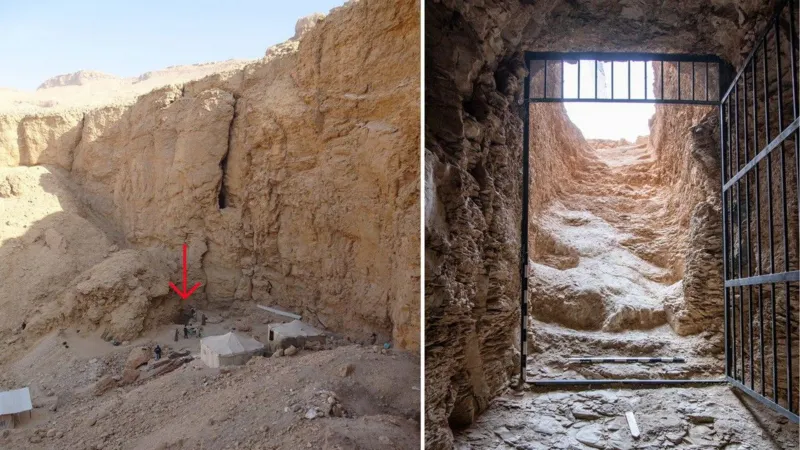International
First Pharaoh’s Tomb Since Tutankhamun Discovered in Egypt

- Archaeologists discover the lost tomb of Pharaoh Thutmose II, the first royal burial found since Tutankhamun.
- The tomb, located near Luxor, was found far from the expected burial site of 18th dynasty pharaohs.
- Researchers confirm its royal status after uncovering a blue-painted ceiling with yellow stars, a feature exclusive to kings’ tombs.
Egyptologists have uncovered the first pharaoh’s tomb discovered since Tutankhamun’s was found over a century ago.
The tomb belongs to King Thutmose II, the last undiscovered royal burial site of Egypt’s 18th dynasty. A British-Egyptian team located it in the Western Valleys of the Theban Necropolis, near Luxor—far from where researchers had long believed the tombs of 18th dynasty pharaohs were situated.
Initially, experts thought these burial chambers were more than 2km away, closer to the Valley of the Kings.
The tomb was found in an area typically associated with royal women’s resting places, but upon entering the burial chamber, the team discovered decorated walls—a sign of a pharaoh’s tomb.
“Part of the ceiling was still intact: a blue-painted ceiling with yellow stars on it. And blue-painted ceilings with yellow stars are only found in kings’ tombs,” explained Dr. Piers Litherland, the field director of the mission.
EDITOR’S PICKS
- 45% of Nigerian Girls Become Mothers Before 18 — World Bank
- ECOWAS Faces Historic Defection as Three West African Nations Withdraw
- Netanyahu to Meet Trump at White House Next Week
Speaking to the BBC’s Newshour, Dr. Litherland described the overwhelming moment of discovery. “The emotion of getting into these things is just one of extraordinary bewilderment because when you come across something you’re not expecting to find, it’s emotionally extremely turbulent,” he said. “And when I came out, my wife was waiting outside, and the only thing I could do was burst into tears.”
This discovery finally resolves the long-standing mystery of where early 18th dynasty pharaohs were buried. Although Thutmose II’s mummified remains were found two centuries ago, his original burial site had remained unknown—until now.
Thutmose II, an ancestor of Tutankhamun, is believed to have reigned between 1493 and 1479 BC. While Tutankhamun’s tomb was famously uncovered by British archaeologists in 1922, Thutmose II’s final resting place had remained a mystery—until now.
Best known as the husband of Queen Hatshepsut, one of Egypt’s most powerful female pharaohs, Thutmose II was buried in a grand tomb featuring a large staircase and an extensive descending corridor, according to Dr. Piers Litherland. He described the painstaking process of accessing the burial chamber, which was obstructed by flood debris and collapsed ceilings.

“It took us a very long time to get through all that,” Dr. Litherland explained. The team had to crawl through a 10-meter (32-foot) passageway with just a 40-centimetre gap at the top before reaching the burial chamber.
Inside, they discovered a blue-painted ceiling with yellow stars—a signature feature of royal tombs—and decorations depicting scenes from the Amduat, an ancient Egyptian funerary text reserved exclusively for pharaohs. These elements confirmed they had located a king’s tomb.
However, instead of a royal burial, they found the chamber completely empty. “Not because it was robbed, but because it had been deliberately emptied,” Dr. Litherland said. Evidence suggested that the tomb had been flooded—it was built beneath a waterfall, and only a few years after the king’s burial, its contents were moved to another location in antiquity.
While sifting through tonnes of limestone debris, the team uncovered fragments of alabaster jars inscribed with the names of Thutmose II and Hatshepsut. These artefacts—likely broken during the tomb’s relocation—became the crucial clue in confirming the burial’s original owner.
FURTHER READING
- [VIDEO] Commotion Rocks PDP BoT Meeting as Faction Confront Each Other
- NiDCOM Prepares for Deportation of Nigerians from U.S
- BREAKING: Sowore Pleads Not Guilty to Cybercrime Charges Filed by Police IG
Dr. Litherland believes a second tomb, possibly still intact and containing royal treasures, is nearby. His team’s discovery marks the culmination of over 12 years of research by the New Kingdom Research Foundation and Egypt’s Ministry of Tourism and Antiquities.
Over the years, the team has excavated 54 tombs in the western Theban mountains near Luxor, identifying more than 30 royal wives and court women.
Egypt’s Minister of Tourism and Antiquities, Sherif Fathy, hailed the discovery as a historic moment:
“This is the first royal tomb to be discovered since the groundbreaking find of King Tutankhamun’s burial chamber in 1922. It is an extraordinary moment for Egyptology and the broader understanding of our shared human story.”
Click here to watch our video of the week:
Advertise or Publish a Story on EkoHot Blog:
Kindly contact us at ekohotblog@gmail.com. Breaking stories should be sent to the above email and substantiated with pictorial evidence.
Citizen journalists will receive a token as data incentive.
Call or Whatsapp: 0803 561 7233, 0703 414 5611

















